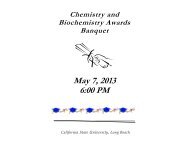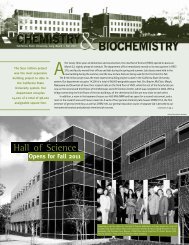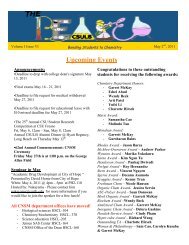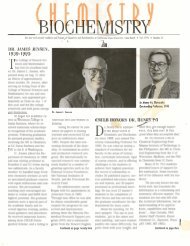2010 - California State University, Long Beach Department of ...
2010 - California State University, Long Beach Department of ...
2010 - California State University, Long Beach Department of ...
You also want an ePaper? Increase the reach of your titles
YUMPU automatically turns print PDFs into web optimized ePapers that Google loves.
4<br />
<strong>Department</strong> Gets<br />
Isothermal Titration<br />
Calorimeter<br />
By Dr. Brian L. McClain<br />
In fall 2009, the <strong>Department</strong> <strong>of</strong> Chemistry and Biochemistry<br />
received a $334,625 Major Research Instrumentation Grant from<br />
the National Science Foundation for the purchase <strong>of</strong> a MicroCal<br />
Auto-iTC200 isothermal titration calorimeter (ITC). The proposal was<br />
written as a collaboration among Drs. Brian McClain, Douglas<br />
McAbee, Eric Marinez, Michael Schramm, Vasanthy Narayanaswami,<br />
Paul Weers and Kasha Slowinska.<br />
ITC is a sensitive, rapid and direct method for measuring the<br />
enthalpy <strong>of</strong> interaction between two chemical species through the<br />
detection <strong>of</strong> heat exchanged when the two species interact. The<br />
instrument is a complement to the MicroCal differential scanning<br />
calorimeter already in the department. The combined use <strong>of</strong> the two<br />
instruments allows full characterization <strong>of</strong> the thermodynamics <strong>of</strong><br />
many chemical systems.<br />
The Microcal Auto-iTC200 provides throughput <strong>of</strong> up to 384<br />
samples with unattended operation; all filling, data collection and<br />
cell cleaning functions are fully automated. The instrument can<br />
directly measure sub-millimolar to nanomolar dissociation constants<br />
and can measure dissociation constants in the nanomolar to picomolar<br />
range using competitive binding techniques. Most important, as<br />
little as 10 µg <strong>of</strong> protein can be used. ITC requires no labeling or<br />
immobilization and presents no buffer restrictions.<br />
Several faculty labs are using the ITC in their research. Dr.<br />
McClain’s lab is studying the binding <strong>of</strong> drugs and fatty acids to<br />
human serum albumin. Dr. Schramm and his students will be looking<br />
at the interaction <strong>of</strong> a-helical peptidomimetics on protein-protein<br />
interactions and at the uptake <strong>of</strong> cavitands by lipid vesicles. Dr.<br />
Marinez's group is using ITC to characterize the binding <strong>of</strong> anions to<br />
synthetic ligands based on enterobactin. Dr. McAbee will be examining<br />
the binding <strong>of</strong> lact<strong>of</strong>errin to the asialoglycoprotein receptor and to<br />
serum proteins. Dr. Narayanaswami's lab will use ITC to characterize<br />
the interaction <strong>of</strong> apolipoprotein E with the low-density lipoprotein<br />
receptor and with the amyloid-beta peptide. Dr. Weers and his students<br />
will investigate the binding <strong>of</strong> apolipoproteins to lipid vesicles<br />
and to lipopolysaccharides. Dr. Slowinska's group will look at the<br />
interaction <strong>of</strong> drugs and other small molecules with a collagen drug<br />
delivery matrix.<br />
The instrument will be housed in the Institute for Integrated<br />
Research in Materials, Environments and Society (IIRMES), and this<br />
will facilitate its use in collaborative and cross-disciplinary research<br />
involving faculty from other departments and other CSU campuses.<br />
The ITC will also be integrated into a number <strong>of</strong> our courses,<br />
including the physical chemistry laboratory course. This will provide<br />
our undergraduate and graduate students with hands-on experience<br />
using one <strong>of</strong> the most ubiquitous bioanalytical instruments currently<br />
available in industry.<br />
The department is fortunate to have this truly state-<strong>of</strong>-the-art<br />
instrument as part <strong>of</strong> its suite <strong>of</strong> modern instrumentation.<br />
<strong>State</strong> Budget Crisis<br />
Affects the <strong>Department</strong><br />
<strong>California</strong>’s ongoing budget crisis continues to affect the <strong>Department</strong><br />
<strong>of</strong> Chemistry and Biochemistry. For 2009-10, with the<br />
state facing a $42 billion deficit, the CSU budget was reduced<br />
by $649 million, a six percent cut. To help address this problem, faculty<br />
and staff voted to accept a furlough program that reduced their number<br />
<strong>of</strong> working days (and their pay) by 9.3 percent. In addition, student<br />
fees were raised by 30 percent, while enrollment was cut. Many classes<br />
were cancelled, and students scrambled to get the courses they needed<br />
to progress toward graduation. Fortunately, at CSULB, the university<br />
was able to tap (and essentially deplete) their reserve funds to mitigate<br />
the effect on course <strong>of</strong>ferings, and a late decision to support additional<br />
sections <strong>of</strong> critical lower division courses from Student Success funds<br />
enabled our department to <strong>of</strong>fer a full schedule <strong>of</strong> classes.<br />
But the cuts were felt in other ways. With class meetings cancelled<br />
because <strong>of</strong> furloughs, it was challenging for faculty to teach courses so<br />
that all essential material in the curriculum could still be covered, and<br />
challenging for students to master the material with less class time.<br />
Tenure-track hiring was cancelled because <strong>of</strong> a lack <strong>of</strong> funds for research<br />
startup expenses. We were not permitted to hire a replacement for our<br />
long-term instrument technician, Bob Soukup (see article on Bob’s<br />
retirement). There was no money to buy new instructional equipment<br />
or to replace existing equipment—lottery funds normally used for this<br />
purpose were diverted to paying for service contracts—and we still had<br />
to cancel contracts on two instruments. There were insufficient<br />
resources to provide matching funds for some faculty grant proposals<br />
and less support for faculty and student travel. Class handouts were<br />
banned in order to save photocopying costs, and faculty were directed<br />
to post material for students online only.<br />
For <strong>2010</strong>-11, the situation is uncertain as <strong>of</strong> this writing. <strong>California</strong><br />
still faces a roughly $19 billion shortfall. The governor’s budget proposal<br />
contains a restoration <strong>of</strong> roughly half the funds that were cut last year.<br />
But the proposed budget faces an uncertain fate in the <strong>California</strong><br />
legis lature, where Democrats may be unwilling to accept other cuts<br />
proposed by the governor, including the elimination <strong>of</strong> the state’s welfare<br />
program, and Republicans continue to oppose any tax increases.<br />
The university is currently planning significant cuts in class <strong>of</strong>ferings.<br />
In our department, this means substantial reductions in lab sections <strong>of</strong><br />
our general education and preparative chemistry classes. Support for<br />
faculty research has been cut substantially, and many tenure track<br />
faculty are carrying heavier teaching loads. We were unable to rehire<br />
a number <strong>of</strong> our part-time lecturers. Other cuts instituted last year<br />
will continue.<br />
As <strong>of</strong> this writing (mid-August), we are waiting to see what type<br />
<strong>of</strong> budget emerges. It is now clear that we will not have a budget in<br />
place by the beginning <strong>of</strong> the fall semester. If a budget is passed during<br />
the coming months that restores to the CSU some <strong>of</strong> the funds cut last<br />
year, it may be possible to <strong>of</strong>fer additional classes in the spring. Our<br />
highest priority is to make sure that our majors and other majors in<br />
areas related to science get the classes they need to make unimpeded<br />
progress toward graduation.


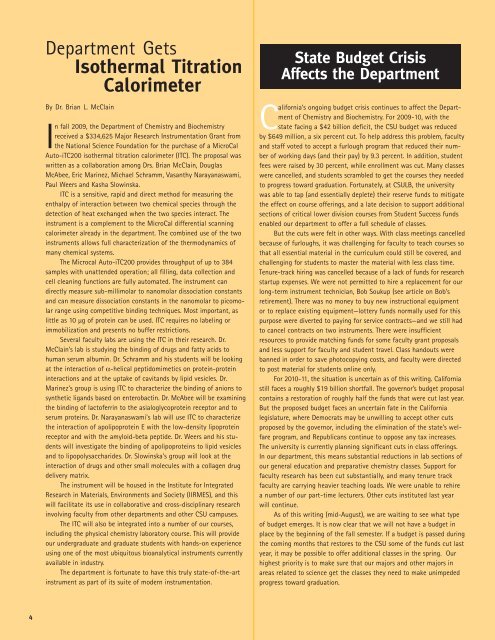
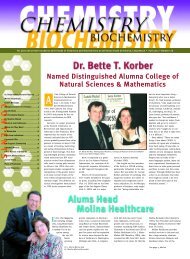
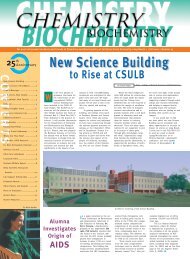
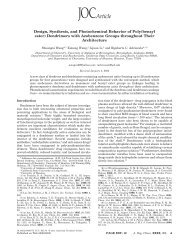
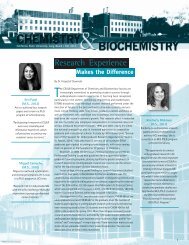
![Volume 4, Issue 3 [November 2012 pdf] - California State University ...](https://img.yumpu.com/34605825/1/190x245/volume-4-issue-3-november-2012-pdf-california-state-university-.jpg?quality=85)
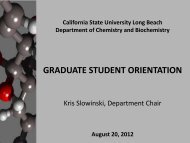
![Volume 5, Issue 2 [April 2013 pdf] - California State University, Long ...](https://img.yumpu.com/33273195/1/190x245/volume-5-issue-2-april-2013-pdf-california-state-university-long-.jpg?quality=85)
